Evidence Based Nursing Research
VerifiedAdded on 2023/04/21
|8
|2168
|158
AI Summary
This article discusses the benefits of skin-to-skin contact in newborns, including improved breastfeeding and mother-child bonding, and the prevention of hypothermia. It also addresses the barriers to implementing skin-to-skin contact in healthcare organizations and provides nursing interventions and patient care recommendations. The article concludes by emphasizing the importance of educating patients and promoting awareness of the benefits of skin-to-skin contact.
Contribute Materials
Your contribution can guide someone’s learning journey. Share your
documents today.
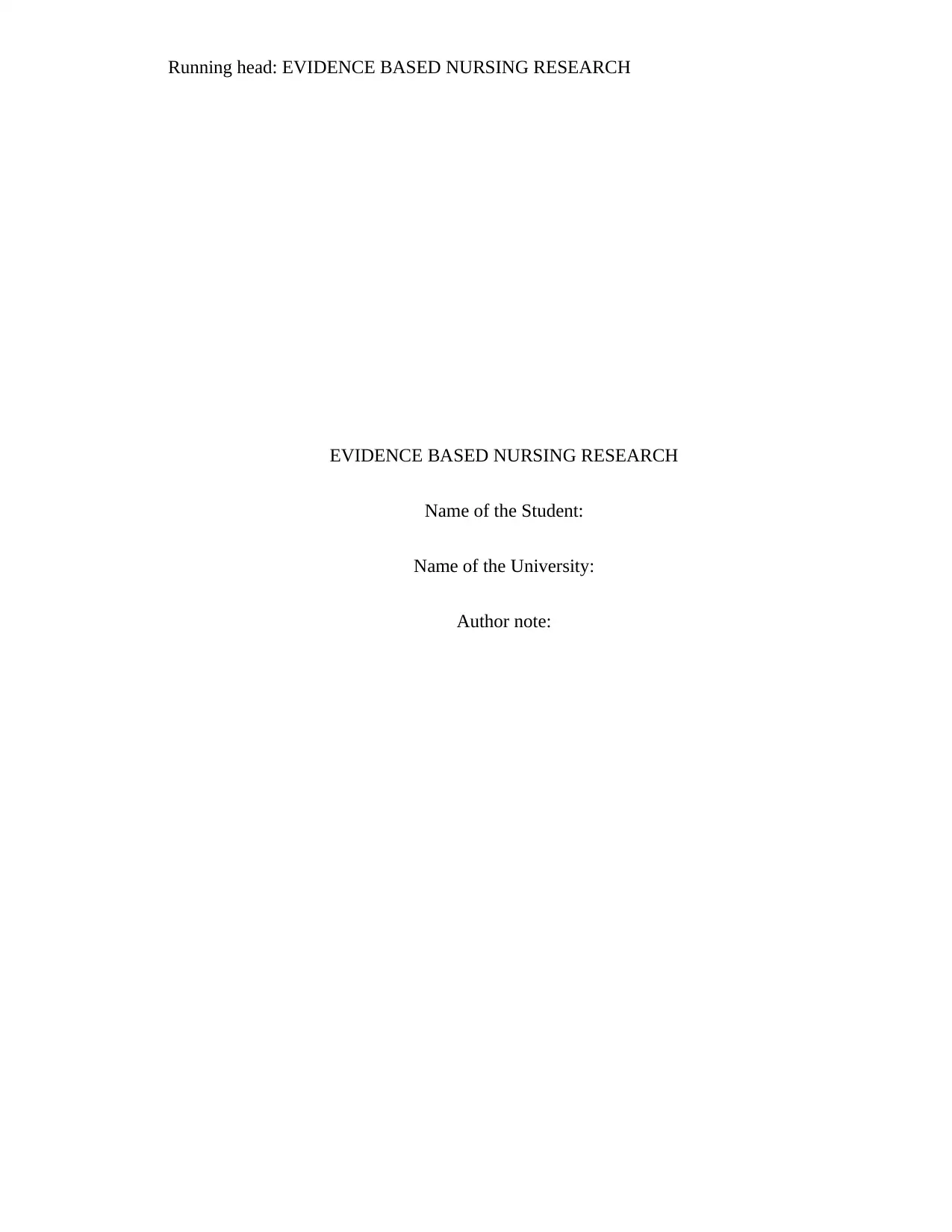
Running head: EVIDENCE BASED NURSING RESEARCH
EVIDENCE BASED NURSING RESEARCH
Name of the Student:
Name of the University:
Author note:
EVIDENCE BASED NURSING RESEARCH
Name of the Student:
Name of the University:
Author note:
Secure Best Marks with AI Grader
Need help grading? Try our AI Grader for instant feedback on your assignments.
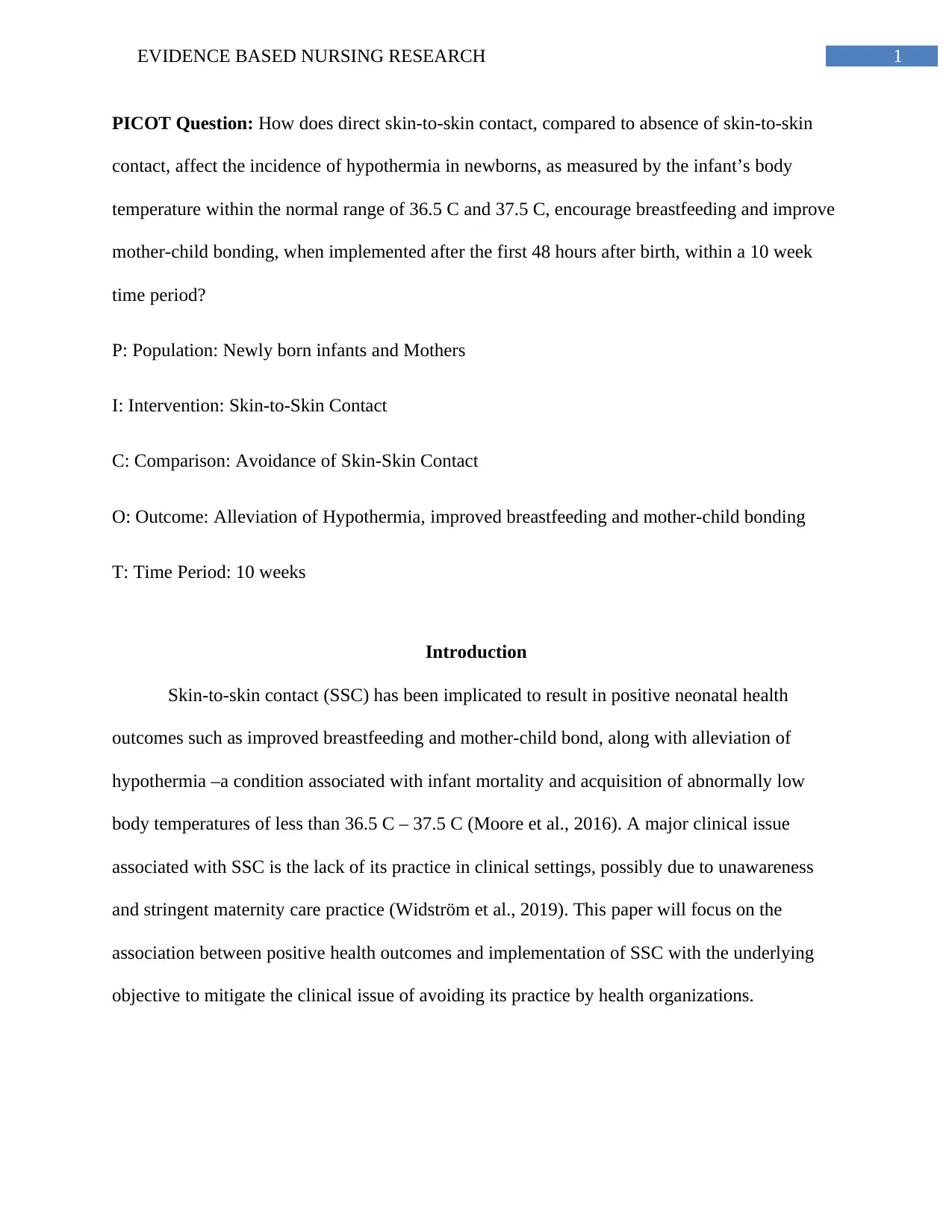
1EVIDENCE BASED NURSING RESEARCH
PICOT Question: How does direct skin-to-skin contact, compared to absence of skin-to-skin
contact, affect the incidence of hypothermia in newborns, as measured by the infant’s body
temperature within the normal range of 36.5 C and 37.5 C, encourage breastfeeding and improve
mother-child bonding, when implemented after the first 48 hours after birth, within a 10 week
time period?
P: Population: Newly born infants and Mothers
I: Intervention: Skin-to-Skin Contact
C: Comparison: Avoidance of Skin-Skin Contact
O: Outcome: Alleviation of Hypothermia, improved breastfeeding and mother-child bonding
T: Time Period: 10 weeks
Introduction
Skin-to-skin contact (SSC) has been implicated to result in positive neonatal health
outcomes such as improved breastfeeding and mother-child bond, along with alleviation of
hypothermia –a condition associated with infant mortality and acquisition of abnormally low
body temperatures of less than 36.5 C – 37.5 C (Moore et al., 2016). A major clinical issue
associated with SSC is the lack of its practice in clinical settings, possibly due to unawareness
and stringent maternity care practice (Widström et al., 2019). This paper will focus on the
association between positive health outcomes and implementation of SSC with the underlying
objective to mitigate the clinical issue of avoiding its practice by health organizations.
PICOT Question: How does direct skin-to-skin contact, compared to absence of skin-to-skin
contact, affect the incidence of hypothermia in newborns, as measured by the infant’s body
temperature within the normal range of 36.5 C and 37.5 C, encourage breastfeeding and improve
mother-child bonding, when implemented after the first 48 hours after birth, within a 10 week
time period?
P: Population: Newly born infants and Mothers
I: Intervention: Skin-to-Skin Contact
C: Comparison: Avoidance of Skin-Skin Contact
O: Outcome: Alleviation of Hypothermia, improved breastfeeding and mother-child bonding
T: Time Period: 10 weeks
Introduction
Skin-to-skin contact (SSC) has been implicated to result in positive neonatal health
outcomes such as improved breastfeeding and mother-child bond, along with alleviation of
hypothermia –a condition associated with infant mortality and acquisition of abnormally low
body temperatures of less than 36.5 C – 37.5 C (Moore et al., 2016). A major clinical issue
associated with SSC is the lack of its practice in clinical settings, possibly due to unawareness
and stringent maternity care practice (Widström et al., 2019). This paper will focus on the
association between positive health outcomes and implementation of SSC with the underlying
objective to mitigate the clinical issue of avoiding its practice by health organizations.
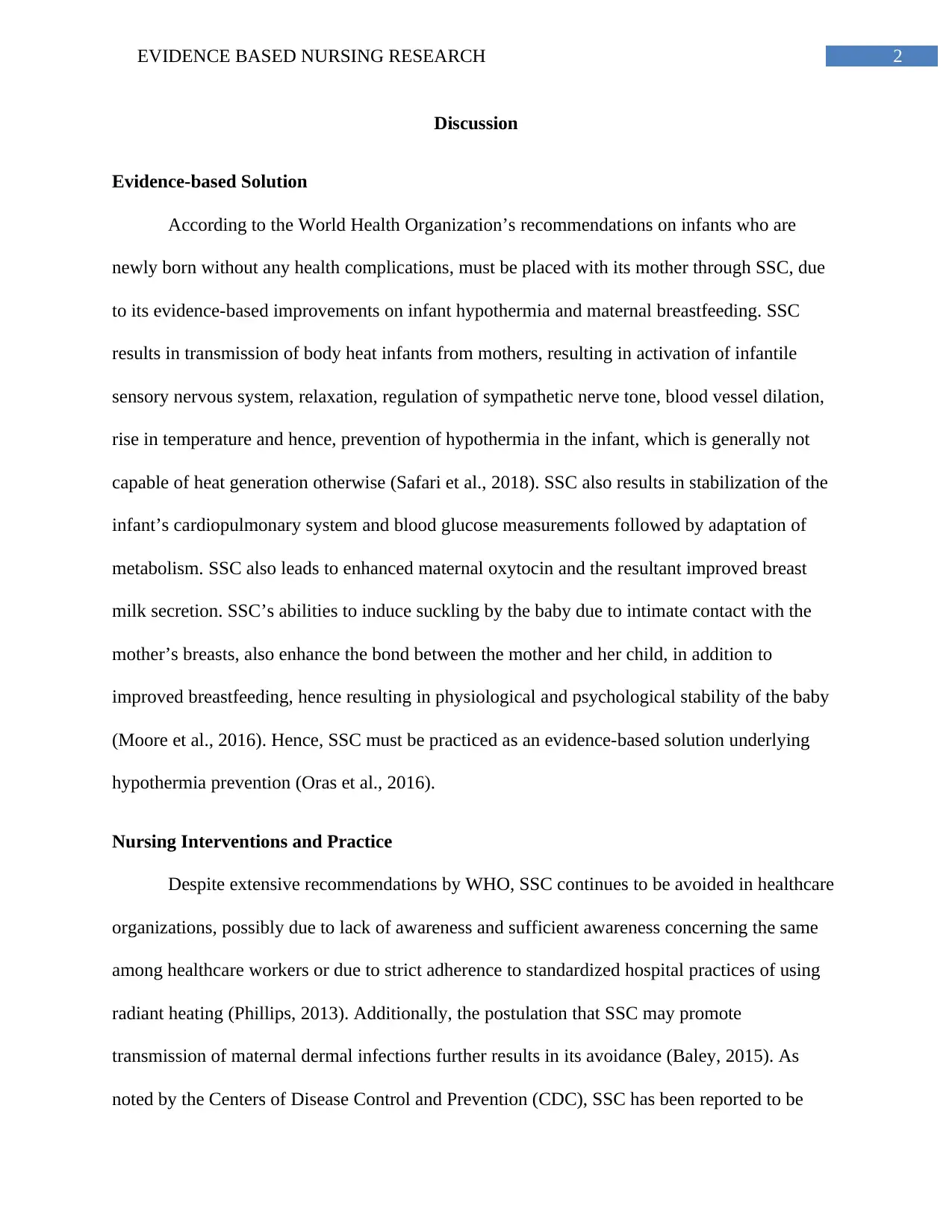
2EVIDENCE BASED NURSING RESEARCH
Discussion
Evidence-based Solution
According to the World Health Organization’s recommendations on infants who are
newly born without any health complications, must be placed with its mother through SSC, due
to its evidence-based improvements on infant hypothermia and maternal breastfeeding. SSC
results in transmission of body heat infants from mothers, resulting in activation of infantile
sensory nervous system, relaxation, regulation of sympathetic nerve tone, blood vessel dilation,
rise in temperature and hence, prevention of hypothermia in the infant, which is generally not
capable of heat generation otherwise (Safari et al., 2018). SSC also results in stabilization of the
infant’s cardiopulmonary system and blood glucose measurements followed by adaptation of
metabolism. SSC also leads to enhanced maternal oxytocin and the resultant improved breast
milk secretion. SSC’s abilities to induce suckling by the baby due to intimate contact with the
mother’s breasts, also enhance the bond between the mother and her child, in addition to
improved breastfeeding, hence resulting in physiological and psychological stability of the baby
(Moore et al., 2016). Hence, SSC must be practiced as an evidence-based solution underlying
hypothermia prevention (Oras et al., 2016).
Nursing Interventions and Practice
Despite extensive recommendations by WHO, SSC continues to be avoided in healthcare
organizations, possibly due to lack of awareness and sufficient awareness concerning the same
among healthcare workers or due to strict adherence to standardized hospital practices of using
radiant heating (Phillips, 2013). Additionally, the postulation that SSC may promote
transmission of maternal dermal infections further results in its avoidance (Baley, 2015). As
noted by the Centers of Disease Control and Prevention (CDC), SSC has been reported to be
Discussion
Evidence-based Solution
According to the World Health Organization’s recommendations on infants who are
newly born without any health complications, must be placed with its mother through SSC, due
to its evidence-based improvements on infant hypothermia and maternal breastfeeding. SSC
results in transmission of body heat infants from mothers, resulting in activation of infantile
sensory nervous system, relaxation, regulation of sympathetic nerve tone, blood vessel dilation,
rise in temperature and hence, prevention of hypothermia in the infant, which is generally not
capable of heat generation otherwise (Safari et al., 2018). SSC also results in stabilization of the
infant’s cardiopulmonary system and blood glucose measurements followed by adaptation of
metabolism. SSC also leads to enhanced maternal oxytocin and the resultant improved breast
milk secretion. SSC’s abilities to induce suckling by the baby due to intimate contact with the
mother’s breasts, also enhance the bond between the mother and her child, in addition to
improved breastfeeding, hence resulting in physiological and psychological stability of the baby
(Moore et al., 2016). Hence, SSC must be practiced as an evidence-based solution underlying
hypothermia prevention (Oras et al., 2016).
Nursing Interventions and Practice
Despite extensive recommendations by WHO, SSC continues to be avoided in healthcare
organizations, possibly due to lack of awareness and sufficient awareness concerning the same
among healthcare workers or due to strict adherence to standardized hospital practices of using
radiant heating (Phillips, 2013). Additionally, the postulation that SSC may promote
transmission of maternal dermal infections further results in its avoidance (Baley, 2015). As
noted by the Centers of Disease Control and Prevention (CDC), SSC has been reported to be
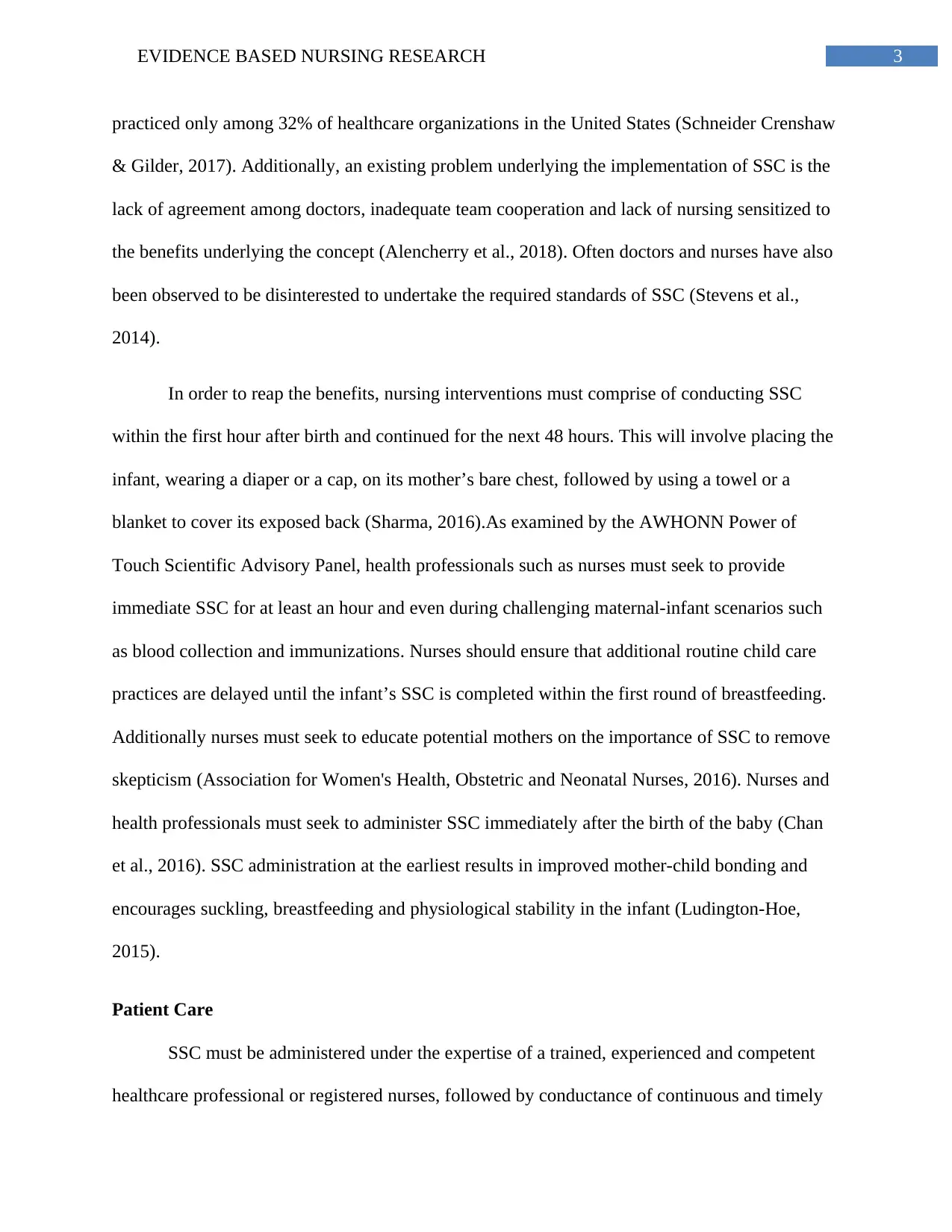
3EVIDENCE BASED NURSING RESEARCH
practiced only among 32% of healthcare organizations in the United States (Schneider Crenshaw
& Gilder, 2017). Additionally, an existing problem underlying the implementation of SSC is the
lack of agreement among doctors, inadequate team cooperation and lack of nursing sensitized to
the benefits underlying the concept (Alencherry et al., 2018). Often doctors and nurses have also
been observed to be disinterested to undertake the required standards of SSC (Stevens et al.,
2014).
In order to reap the benefits, nursing interventions must comprise of conducting SSC
within the first hour after birth and continued for the next 48 hours. This will involve placing the
infant, wearing a diaper or a cap, on its mother’s bare chest, followed by using a towel or a
blanket to cover its exposed back (Sharma, 2016).As examined by the AWHONN Power of
Touch Scientific Advisory Panel, health professionals such as nurses must seek to provide
immediate SSC for at least an hour and even during challenging maternal-infant scenarios such
as blood collection and immunizations. Nurses should ensure that additional routine child care
practices are delayed until the infant’s SSC is completed within the first round of breastfeeding.
Additionally nurses must seek to educate potential mothers on the importance of SSC to remove
skepticism (Association for Women's Health, Obstetric and Neonatal Nurses, 2016). Nurses and
health professionals must seek to administer SSC immediately after the birth of the baby (Chan
et al., 2016). SSC administration at the earliest results in improved mother-child bonding and
encourages suckling, breastfeeding and physiological stability in the infant (Ludington-Hoe,
2015).
Patient Care
SSC must be administered under the expertise of a trained, experienced and competent
healthcare professional or registered nurses, followed by conductance of continuous and timely
practiced only among 32% of healthcare organizations in the United States (Schneider Crenshaw
& Gilder, 2017). Additionally, an existing problem underlying the implementation of SSC is the
lack of agreement among doctors, inadequate team cooperation and lack of nursing sensitized to
the benefits underlying the concept (Alencherry et al., 2018). Often doctors and nurses have also
been observed to be disinterested to undertake the required standards of SSC (Stevens et al.,
2014).
In order to reap the benefits, nursing interventions must comprise of conducting SSC
within the first hour after birth and continued for the next 48 hours. This will involve placing the
infant, wearing a diaper or a cap, on its mother’s bare chest, followed by using a towel or a
blanket to cover its exposed back (Sharma, 2016).As examined by the AWHONN Power of
Touch Scientific Advisory Panel, health professionals such as nurses must seek to provide
immediate SSC for at least an hour and even during challenging maternal-infant scenarios such
as blood collection and immunizations. Nurses should ensure that additional routine child care
practices are delayed until the infant’s SSC is completed within the first round of breastfeeding.
Additionally nurses must seek to educate potential mothers on the importance of SSC to remove
skepticism (Association for Women's Health, Obstetric and Neonatal Nurses, 2016). Nurses and
health professionals must seek to administer SSC immediately after the birth of the baby (Chan
et al., 2016). SSC administration at the earliest results in improved mother-child bonding and
encourages suckling, breastfeeding and physiological stability in the infant (Ludington-Hoe,
2015).
Patient Care
SSC must be administered under the expertise of a trained, experienced and competent
healthcare professional or registered nurses, followed by conductance of continuous and timely
Secure Best Marks with AI Grader
Need help grading? Try our AI Grader for instant feedback on your assignments.
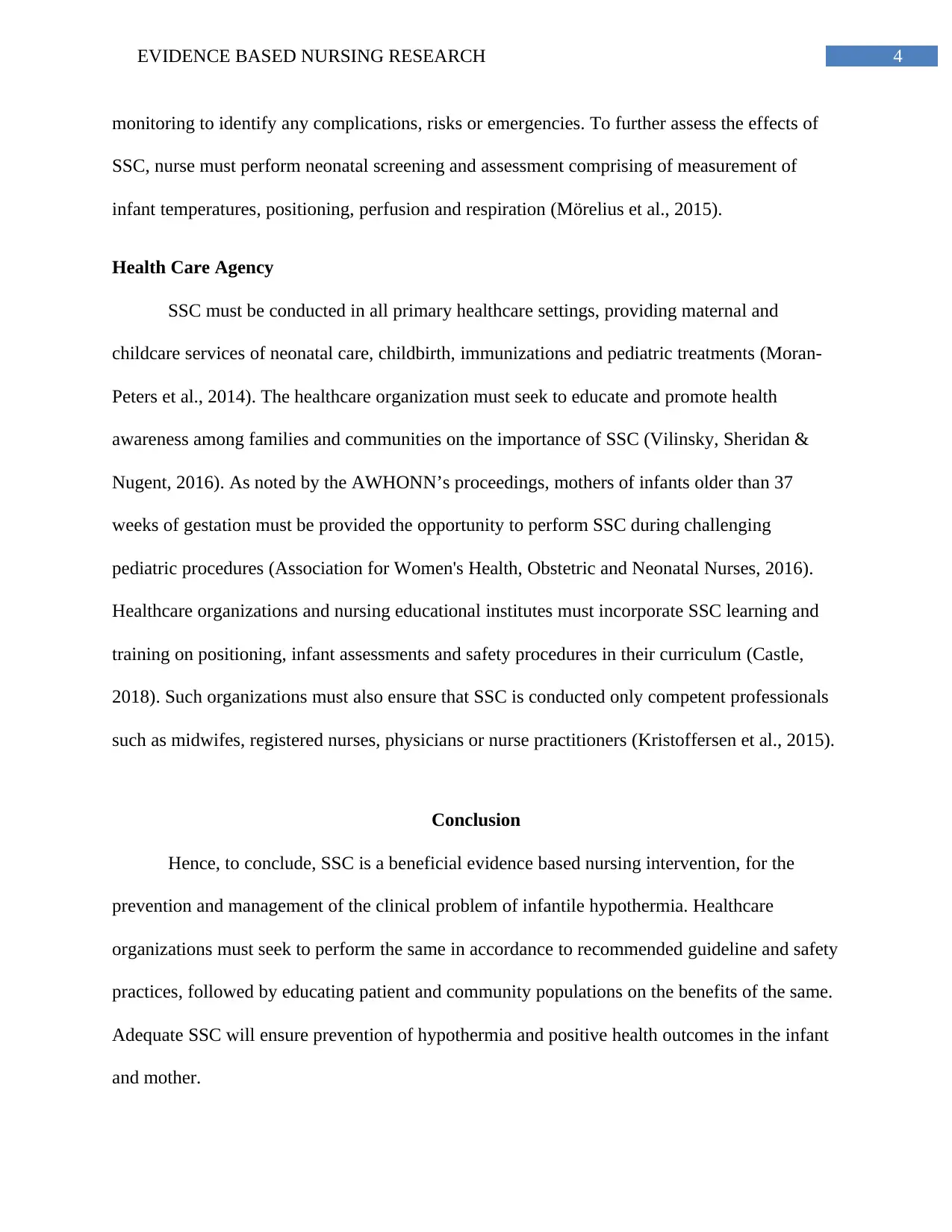
4EVIDENCE BASED NURSING RESEARCH
monitoring to identify any complications, risks or emergencies. To further assess the effects of
SSC, nurse must perform neonatal screening and assessment comprising of measurement of
infant temperatures, positioning, perfusion and respiration (Mörelius et al., 2015).
Health Care Agency
SSC must be conducted in all primary healthcare settings, providing maternal and
childcare services of neonatal care, childbirth, immunizations and pediatric treatments (Moran-
Peters et al., 2014). The healthcare organization must seek to educate and promote health
awareness among families and communities on the importance of SSC (Vilinsky, Sheridan &
Nugent, 2016). As noted by the AWHONN’s proceedings, mothers of infants older than 37
weeks of gestation must be provided the opportunity to perform SSC during challenging
pediatric procedures (Association for Women's Health, Obstetric and Neonatal Nurses, 2016).
Healthcare organizations and nursing educational institutes must incorporate SSC learning and
training on positioning, infant assessments and safety procedures in their curriculum (Castle,
2018). Such organizations must also ensure that SSC is conducted only competent professionals
such as midwifes, registered nurses, physicians or nurse practitioners (Kristoffersen et al., 2015).
Conclusion
Hence, to conclude, SSC is a beneficial evidence based nursing intervention, for the
prevention and management of the clinical problem of infantile hypothermia. Healthcare
organizations must seek to perform the same in accordance to recommended guideline and safety
practices, followed by educating patient and community populations on the benefits of the same.
Adequate SSC will ensure prevention of hypothermia and positive health outcomes in the infant
and mother.
monitoring to identify any complications, risks or emergencies. To further assess the effects of
SSC, nurse must perform neonatal screening and assessment comprising of measurement of
infant temperatures, positioning, perfusion and respiration (Mörelius et al., 2015).
Health Care Agency
SSC must be conducted in all primary healthcare settings, providing maternal and
childcare services of neonatal care, childbirth, immunizations and pediatric treatments (Moran-
Peters et al., 2014). The healthcare organization must seek to educate and promote health
awareness among families and communities on the importance of SSC (Vilinsky, Sheridan &
Nugent, 2016). As noted by the AWHONN’s proceedings, mothers of infants older than 37
weeks of gestation must be provided the opportunity to perform SSC during challenging
pediatric procedures (Association for Women's Health, Obstetric and Neonatal Nurses, 2016).
Healthcare organizations and nursing educational institutes must incorporate SSC learning and
training on positioning, infant assessments and safety procedures in their curriculum (Castle,
2018). Such organizations must also ensure that SSC is conducted only competent professionals
such as midwifes, registered nurses, physicians or nurse practitioners (Kristoffersen et al., 2015).
Conclusion
Hence, to conclude, SSC is a beneficial evidence based nursing intervention, for the
prevention and management of the clinical problem of infantile hypothermia. Healthcare
organizations must seek to perform the same in accordance to recommended guideline and safety
practices, followed by educating patient and community populations on the benefits of the same.
Adequate SSC will ensure prevention of hypothermia and positive health outcomes in the infant
and mother.

5EVIDENCE BASED NURSING RESEARCH
References
Alenchery, A. J., Thoppil, J., Britto, C. D., de Onis, J. V., Fernandez, L., & Rao, P. S. (2018).
Barriers and enablers to skin-to-skin contact at birth in healthy neonates-a qualitative
study. BMC pediatrics, 18(1), 48. https://doi.org/10.1186/s12887-018-1033-y.
Association for Women's Health, Obstetric and Neonatal Nurses. (2016).Immediate and
Sustained Skin-to-Skin Contact for the Healthy Term Newborn After Birth: AWHONN
Practice Brief Number 5. (2016). Journal Of Obstetric, Gynecologic & Neonatal
Nursing, 45(6), 842-844. doi: 10.1016/j.jogn.2016.09.001.
Baley, J. (2015). Skin-to-skin care for term and preterm infants in the neonatal
ICU. Pediatrics, 136(3), 596-599. doi: 10.1542/peds.2015-2335.
Kristoffersen, L., Stoen, R., Hansen, L. F., Wilhelmsen, J., & Bergseng, H. (2016). Skin-to-skin
care after birth for moderately preterm infants. Journal of Obstetric, Gynecologic &
Neonatal Nursing, 45(3), 339-345. doi: https://doi.org/10.1016/j.jogn.2016.02.007.
Moore, E. R., Bergman, N., Anderson, G. C., & Medley, N. (2016). Early skin‐to‐skin contact
for mothers and their healthy newborn infants. Cochrane database of systematic Reviews,
(11). doi: 10.1002/14651858.CD003519.pub4.
Moore, E. R., Bergman, N., Anderson, G. C., & Medley, N. (2016). Early skin‐to‐skin contact
for mothers and their healthy newborn infants. Cochrane database of systematic Reviews,
(11). doi/10.1002/14651858.CD003519.pub4.
Mörelius, E., Örtenstrand, A., Theodorsson, E., & Frostell, A. (2015). A randomised trial of
continuous skin-to-skin contact after preterm birth and the effects on salivary cortisol,
References
Alenchery, A. J., Thoppil, J., Britto, C. D., de Onis, J. V., Fernandez, L., & Rao, P. S. (2018).
Barriers and enablers to skin-to-skin contact at birth in healthy neonates-a qualitative
study. BMC pediatrics, 18(1), 48. https://doi.org/10.1186/s12887-018-1033-y.
Association for Women's Health, Obstetric and Neonatal Nurses. (2016).Immediate and
Sustained Skin-to-Skin Contact for the Healthy Term Newborn After Birth: AWHONN
Practice Brief Number 5. (2016). Journal Of Obstetric, Gynecologic & Neonatal
Nursing, 45(6), 842-844. doi: 10.1016/j.jogn.2016.09.001.
Baley, J. (2015). Skin-to-skin care for term and preterm infants in the neonatal
ICU. Pediatrics, 136(3), 596-599. doi: 10.1542/peds.2015-2335.
Kristoffersen, L., Stoen, R., Hansen, L. F., Wilhelmsen, J., & Bergseng, H. (2016). Skin-to-skin
care after birth for moderately preterm infants. Journal of Obstetric, Gynecologic &
Neonatal Nursing, 45(3), 339-345. doi: https://doi.org/10.1016/j.jogn.2016.02.007.
Moore, E. R., Bergman, N., Anderson, G. C., & Medley, N. (2016). Early skin‐to‐skin contact
for mothers and their healthy newborn infants. Cochrane database of systematic Reviews,
(11). doi: 10.1002/14651858.CD003519.pub4.
Moore, E. R., Bergman, N., Anderson, G. C., & Medley, N. (2016). Early skin‐to‐skin contact
for mothers and their healthy newborn infants. Cochrane database of systematic Reviews,
(11). doi/10.1002/14651858.CD003519.pub4.
Mörelius, E., Örtenstrand, A., Theodorsson, E., & Frostell, A. (2015). A randomised trial of
continuous skin-to-skin contact after preterm birth and the effects on salivary cortisol,

6EVIDENCE BASED NURSING RESEARCH
parental stress, depression, and breastfeeding. Early human development, 91(1), 63-70.
doi: https://doi.org/10.1016/j.earlhumdev.2014.12.005.
Oras, P., Thernström Blomqvist, Y., Hedberg Nyqvist, K., Gradin, M., Rubertsson, C.,
Hellström‐Westas, L., & Funkquist, E. L. (2016). Skin‐to‐skin contact is associated with
earlier breastfeeding attainment in preterm infants. Acta Paediatrica, 105(7), 783-789.
doi: https://doi.org/10.1111/apa.13431.
Safari, K., Saeed, A. A., Hasan, S. S., & Moghaddam-Banaem, L. (2018). The effect of mother
and newborn early skin-to-skin contact on initiation of breastfeeding, newborn
temperature and duration of third stage of labor. International breastfeeding
journal, 13(1), 32. doi: https://dx.doi.org/10.1186%2Fs13006-018-0174-9.
Schneider, L. W., Crenshaw, J. T., & Gilder, R. E. (2017). Influence of immediate skin-to-skin
contact during cesarean surgery on rate of transfer of newborns to NICU for
observation. Nursing for women's health, 21(1), 28-33. doi:
https://doi.org/10.1016/j.nwh.2016.12.008.
Sharma, A. (2016). Efficacy of early skin-to-skin contact on the rate of exclusive breastfeeding
in term neonates: a randomized controlled trial. African health sciences, 16(3), 790-797.
doi: http://dx.doi.org/10.4314/ahs.v16i3.20.
Vilinsky, A., Sheridan, A., & Nugent, L. E. (2016). Preventing peri-operative maternal and
neonatal hypothermia after skin-to-skin contact. Journal of Neonatal Nursing, 22(4), 163-
170. doi: https://doi.org/10.1016/j.jnn.2016.02.002.
parental stress, depression, and breastfeeding. Early human development, 91(1), 63-70.
doi: https://doi.org/10.1016/j.earlhumdev.2014.12.005.
Oras, P., Thernström Blomqvist, Y., Hedberg Nyqvist, K., Gradin, M., Rubertsson, C.,
Hellström‐Westas, L., & Funkquist, E. L. (2016). Skin‐to‐skin contact is associated with
earlier breastfeeding attainment in preterm infants. Acta Paediatrica, 105(7), 783-789.
doi: https://doi.org/10.1111/apa.13431.
Safari, K., Saeed, A. A., Hasan, S. S., & Moghaddam-Banaem, L. (2018). The effect of mother
and newborn early skin-to-skin contact on initiation of breastfeeding, newborn
temperature and duration of third stage of labor. International breastfeeding
journal, 13(1), 32. doi: https://dx.doi.org/10.1186%2Fs13006-018-0174-9.
Schneider, L. W., Crenshaw, J. T., & Gilder, R. E. (2017). Influence of immediate skin-to-skin
contact during cesarean surgery on rate of transfer of newborns to NICU for
observation. Nursing for women's health, 21(1), 28-33. doi:
https://doi.org/10.1016/j.nwh.2016.12.008.
Sharma, A. (2016). Efficacy of early skin-to-skin contact on the rate of exclusive breastfeeding
in term neonates: a randomized controlled trial. African health sciences, 16(3), 790-797.
doi: http://dx.doi.org/10.4314/ahs.v16i3.20.
Vilinsky, A., Sheridan, A., & Nugent, L. E. (2016). Preventing peri-operative maternal and
neonatal hypothermia after skin-to-skin contact. Journal of Neonatal Nursing, 22(4), 163-
170. doi: https://doi.org/10.1016/j.jnn.2016.02.002.
Paraphrase This Document
Need a fresh take? Get an instant paraphrase of this document with our AI Paraphraser
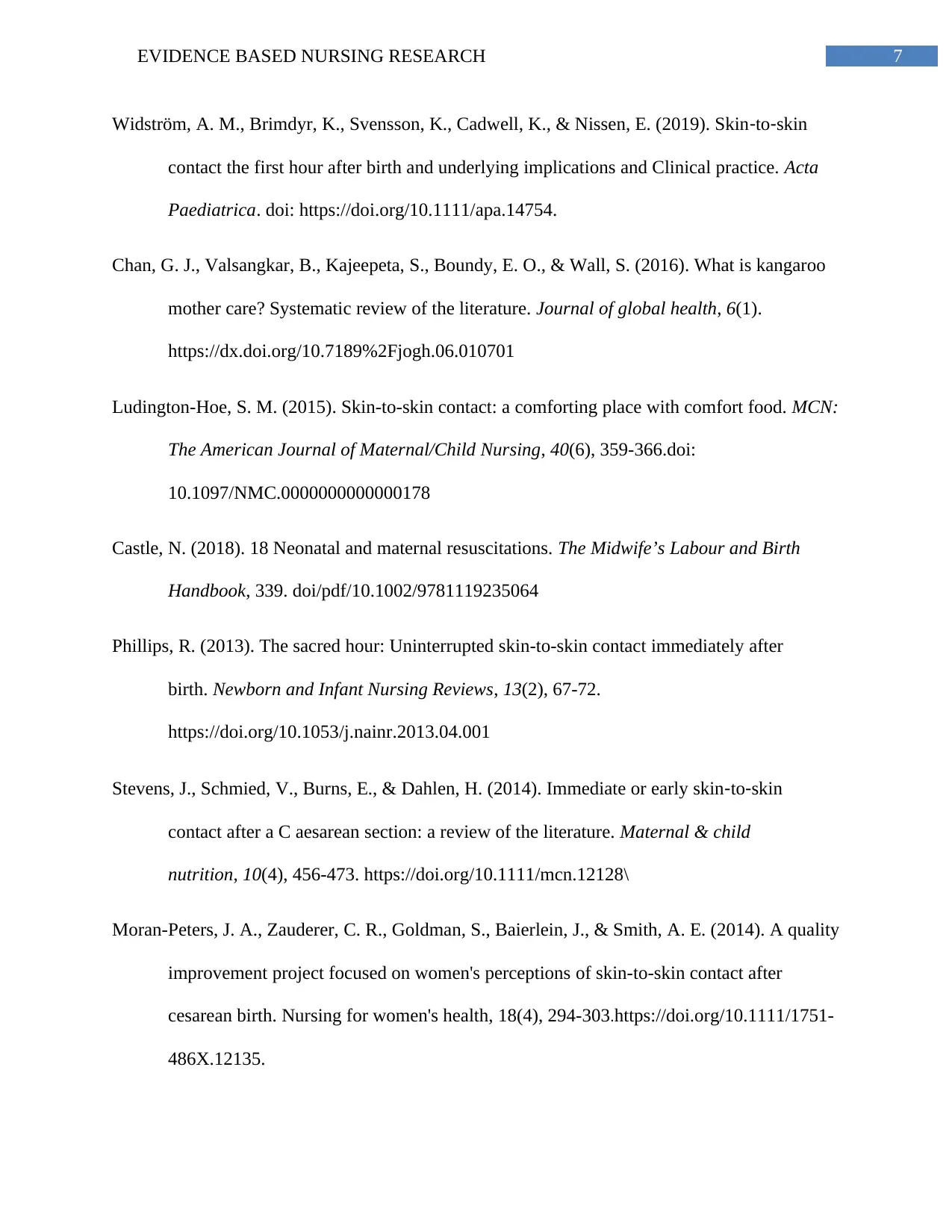
7EVIDENCE BASED NURSING RESEARCH
Widström, A. M., Brimdyr, K., Svensson, K., Cadwell, K., & Nissen, E. (2019). Skin‐to‐skin
contact the first hour after birth and underlying implications and Clinical practice. Acta
Paediatrica. doi: https://doi.org/10.1111/apa.14754.
Chan, G. J., Valsangkar, B., Kajeepeta, S., Boundy, E. O., & Wall, S. (2016). What is kangaroo
mother care? Systematic review of the literature. Journal of global health, 6(1).
https://dx.doi.org/10.7189%2Fjogh.06.010701
Ludington-Hoe, S. M. (2015). Skin-to-skin contact: a comforting place with comfort food. MCN:
The American Journal of Maternal/Child Nursing, 40(6), 359-366.doi:
10.1097/NMC.0000000000000178
Castle, N. (2018). 18 Neonatal and maternal resuscitations. The Midwife’s Labour and Birth
Handbook, 339. doi/pdf/10.1002/9781119235064
Phillips, R. (2013). The sacred hour: Uninterrupted skin-to-skin contact immediately after
birth. Newborn and Infant Nursing Reviews, 13(2), 67-72.
https://doi.org/10.1053/j.nainr.2013.04.001
Stevens, J., Schmied, V., Burns, E., & Dahlen, H. (2014). Immediate or early skin‐to‐skin
contact after a C aesarean section: a review of the literature. Maternal & child
nutrition, 10(4), 456-473. https://doi.org/10.1111/mcn.12128\
Moran-Peters, J. A., Zauderer, C. R., Goldman, S., Baierlein, J., & Smith, A. E. (2014). A quality
improvement project focused on women's perceptions of skin-to-skin contact after
cesarean birth. Nursing for women's health, 18(4), 294-303.https://doi.org/10.1111/1751-
486X.12135.
Widström, A. M., Brimdyr, K., Svensson, K., Cadwell, K., & Nissen, E. (2019). Skin‐to‐skin
contact the first hour after birth and underlying implications and Clinical practice. Acta
Paediatrica. doi: https://doi.org/10.1111/apa.14754.
Chan, G. J., Valsangkar, B., Kajeepeta, S., Boundy, E. O., & Wall, S. (2016). What is kangaroo
mother care? Systematic review of the literature. Journal of global health, 6(1).
https://dx.doi.org/10.7189%2Fjogh.06.010701
Ludington-Hoe, S. M. (2015). Skin-to-skin contact: a comforting place with comfort food. MCN:
The American Journal of Maternal/Child Nursing, 40(6), 359-366.doi:
10.1097/NMC.0000000000000178
Castle, N. (2018). 18 Neonatal and maternal resuscitations. The Midwife’s Labour and Birth
Handbook, 339. doi/pdf/10.1002/9781119235064
Phillips, R. (2013). The sacred hour: Uninterrupted skin-to-skin contact immediately after
birth. Newborn and Infant Nursing Reviews, 13(2), 67-72.
https://doi.org/10.1053/j.nainr.2013.04.001
Stevens, J., Schmied, V., Burns, E., & Dahlen, H. (2014). Immediate or early skin‐to‐skin
contact after a C aesarean section: a review of the literature. Maternal & child
nutrition, 10(4), 456-473. https://doi.org/10.1111/mcn.12128\
Moran-Peters, J. A., Zauderer, C. R., Goldman, S., Baierlein, J., & Smith, A. E. (2014). A quality
improvement project focused on women's perceptions of skin-to-skin contact after
cesarean birth. Nursing for women's health, 18(4), 294-303.https://doi.org/10.1111/1751-
486X.12135.
1 out of 8
Related Documents
Your All-in-One AI-Powered Toolkit for Academic Success.
+13062052269
info@desklib.com
Available 24*7 on WhatsApp / Email
![[object Object]](/_next/static/media/star-bottom.7253800d.svg)
Unlock your academic potential
© 2024 | Zucol Services PVT LTD | All rights reserved.





